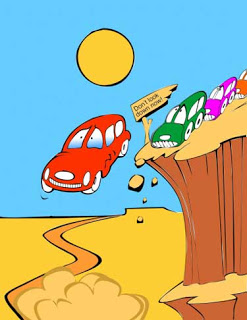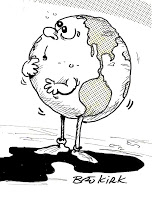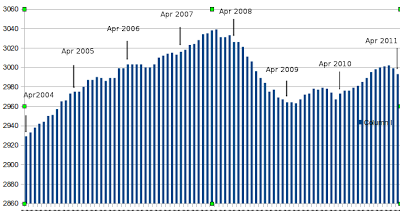Coming soon:
Peak oil, peak driving, peak cars
Part II: Have we turned the corner on peak driving?
By Roger Baker / The Rag Blog / June 23, 2011
This is the second part of a series by Roger Baker on transportation, centering on peak oil and its ramifications.
Tell the average U.S. car owner that total driving in the USA might have already peaked forever, and they are likely to think you’re crazy. That possibility goes against a lifetime of their personal experience, living as we do in a country dependent on personal vehicles for work trips and various other vital functions.
It doesn’t seem possible that total driving could peak and decline in our lifetimes, especially given an ever increasing population. Cars and their social and economic implications might be said to be the primary basis for the prevailing U.S. lifestyle and culture.
We see evidence for a shift in driving behavior in many places. Indeed, evidence for a driving slowdown clearly predates the big 2008 run-up in fuel prices. There are a number of factors at work. High unemployment cuts down on work trips. Intractable traffic congestion associated with suburban commuting in most U.S. metropolitan areas plays a role. As the U.S. population ages, it is driving less.
According to the best data, collected by hundreds of stations around the USA by the Federal Highway Administration, the total amount of U.S. driving, called VMT or vehicle miles traveled, hit a peak of about 3.04 trillion miles of travel in 2007. Since 2007, travel volume has been making a sluggish recovery, but U.S. driving is still over 1 percent below the level of four years ago.
Here is my expanded version, including the latest month available, the VMT for April 2011, and extending back for each month since 2004. We can see there were several years of a weaker increase, beginning about mid-2005. As gas prices rose during 2008, total driving took a nosedive and then made a slow bumpy recovery during 2009-2010. In early 2011, driving has dropped again, likely in response to sharply higher fuel prices.
CLICK ON IMAGE TO ENLARGE.
If we are optimists, we can look at this chart and argue the VMT numbers might keep rising at the current sluggish rate. Purely by eyeballing the chart, it looks like U.S. travel volume might possibly recover to reach its old 2007 peak in two years or so. The likelihood of higher oil prices and the slow replacement of the existing vehicle fleet suggest that this is unlikely to happen.
The U.S. vehicle fleet of cars, light trucks, etc may already be past its peak. The total number of private vehicles reached a high of about 250 million in 2008.
An excellent analysis of the changing economics of U.S. transportation has been provided by Worldwatch Institute founder Lester Brown. He points out that In 2009 alone, car ownership declined by about 4 million vehicles, or about 2%.
Future U.S. fleet size will be determined by the relationship between two trends: new car sales and cars scrapped. Cars scrapped exceeded new car sales in 2009 for the first time since World War II, shrinking the U.S. vehicle fleet from the all-time high of 250 million to 246 million. It now appears that this new trend of scrappage exceeding sales could continue through at least 2020.
The basic case for peak driving and peak cars is that driving is becoming increasingly unaffordable for the steadily growing ranks of low income drivers, in a nation where vehicle ownership is highly correlated with income. Annual car ownership cost is now estimated at $9000.
 Meanwhile, many experts now believe that we are very near or past peak global oil production. Given a steadily growing demand for a shrinking global oil supply, the lack of practical alternatives is bound to make driving in the U.S. steadily less affordable. This is doubly the case when rising fuel prices act like a tax that competes with, and depresses, consumer spending in other sectors of the economy.
Meanwhile, many experts now believe that we are very near or past peak global oil production. Given a steadily growing demand for a shrinking global oil supply, the lack of practical alternatives is bound to make driving in the U.S. steadily less affordable. This is doubly the case when rising fuel prices act like a tax that competes with, and depresses, consumer spending in other sectors of the economy.
Until the U.S. economy recovers, it is hard to see how driving and car sales can recover. Assuming the U.S. and global economy do recover, it is just as hard to imagine a scenario in which basic supply and demand will not raise the cost of fuel high enough to kill the economic recovery, much as we saw in 2008 when the price of oil reached $147 a barrel.
If we knew the state of the U.S. economy a year from now, and an average driver’s fuel costs, we would be in a good position to predict the level of driving. Since the economy is unlikely to recover much the next year, in terms of the part of family income that can be devoted to driving, the wild card, the biggest source of economic uncertainty, is the cost of motor fuel next year and beyond.
The Road Lobby:
Why public planners hate the concept of peak driving
The reality of peak driving and peak cars on the road is guaranteed to be seen as unwelcome, and to be unpopular among planners. Planning for peak driving deeply disturbs the basis for business as usual, an unpopularity it shares with measures to limit global warming. Peak driving is subversive of existing interests since so much existing investment and infrastructure is based on the status quo.
There are a constellation of powerful financial interests tied in one way or another to the automobile, all sharing in common an interest in the continuation and expansion of a car-centric and oil-addictive U.S. suburban lifestyle. These interests include the car building industry, the road construction industry, the home products industry, and also include the various suburban sprawl and home-building beneficiaries.
Most transportation planners and their allies — ranging from Exxon, to Walmart, to General Motors — are inclined by the nature of their existing investments to favor roads and driving as the way to serve a profitable continuation of the prevailing pattern of suburban development.
It should come as no surprise that there is an active road lobby with many branches dedicated to perpetuating the privately profitable aspects of driving. The road lobby has its own stable of activist driving promoters like Wendell Cox and Randal O’Toole, both stridently pro-road and anti-transit. If there is a toll road lobby it is probably centered around Peter Samuel and Toll Roads News.
The Texas Transportation Institute is essentially the academic think tank of the Texas road lobby. It offers an academic fig leaf of respectability to the active promotion of roads and cars and driving as unchallenged core values and infrastructure funding assumptions.
One of their current projects is to study, and prove the necessity for, a new tax on miles driven to replace or supplement the current fuel tax. The fact that the road lobby would be suggesting what is guaranteed to be such a highly unpopular kind of tax only underlines the deteriorating economics of driving.
The road lobby, in its more overtly and stridently political manifestation, often maintains that the ability to drive anywhere is a basic civil right under attack by transit advocates and urban planners inside government. At any rate, this outlook applies when the planners are not primarily trying to build more roads. Especially the roads that subsidize the suburban growth surrounding major U.S. metropolitan areas, where most state and federal planners are still focusing their attention.
The ultimate futility of subsidizing suburban sprawl development with more roads comes as no surprise. The case was already solidly made in 2004 in the classic peak oil documentary, “The End of Suburbia.”
The degree to which supposedly near-universal car ownership is threatened by a relatively declining U.S. household income is a factor that U.S. transportation planners are especially reluctant to admit. The reality is that rising fuel prices and a stagnant economy are fundamentally changing the economics of transportation and forcing the growing ranks of the poor to give up their cars.
Next time: A deeper look at what is by now an overwhelming body of evidence that U.S. driving behavior is fundamentally changing in response to our changing economy. The closer you look, the more apparent that a basic shift is really taking place. But what will the public transportation alternative look like by the time the public widely appreciates how much they really need it?
 [Roger Baker is a long time transportation-oriented environmental activist, an amateur energy-oriented economist, an amateur scientist and science writer, and a founding member of and an advisor to the Association for the Study of Peak Oil-USA. He is active in the Green Party and the ACLU, and is a director of the Save Our Springs Association and the Save Barton Creek Association in Austin. Mostly he enjoys being an irreverent policy wonk and writing irreverent wonkish articles for The Rag Blog. Read more articles by Roger Baker on The Rag Blog.]
[Roger Baker is a long time transportation-oriented environmental activist, an amateur energy-oriented economist, an amateur scientist and science writer, and a founding member of and an advisor to the Association for the Study of Peak Oil-USA. He is active in the Green Party and the ACLU, and is a director of the Save Our Springs Association and the Save Barton Creek Association in Austin. Mostly he enjoys being an irreverent policy wonk and writing irreverent wonkish articles for The Rag Blog. Read more articles by Roger Baker on The Rag Blog.]



















